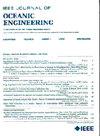SCN: A Novel Underwater Images Enhancement Method Based on Single Channel Network Model
IF 5.3
2区 工程技术
Q1 ENGINEERING, CIVIL
引用次数: 0
Abstract
Light is absorbed, reflected, and refracted in an underwater environment due to the interaction between water and light. The red and blue channels in an image are attenuated due to these interactions. The red, green, and blue channels are typically employed as inputs for deep learning models, and the color casts, which result from different attenuation rates of the three channels, may affect the model's generalization performance. Besides, the color casts existing in the reference images will impact the deep-learning models. To address these challenges, a single channel network (SCN) model is introduced, which exclusively employs the green channel as its input, and is unaffected by the attenuations in the red and blue channels. An innovative feature processing module is presented, in which the characteristics of transformers and convolutional layers are fused to capture nonlinear relationships among the red, green, and blue channels. The public EUVP and LSUI data set experiments show that the proposed SCN model achieves competitive results with the existing best three channel models for the case of slight signal attenuation, and outperforms the existing state of arts three-channel models for the case of strong signal attenuation. Furthermore, the proposed model is trained on the self-built noncolor biased underwater image data set and is also tested on the public UCCS data set with three different types of color casts, whose experimental results exhibit balanced color distribution.基于单通道网络模型的水下图像增强新方法
由于水和光之间的相互作用,光在水下环境中被吸收、反射和折射。图像中的红色和蓝色通道由于这些相互作用而衰减。深度学习模型通常采用红、绿、蓝三种通道作为输入,三种通道的衰减率不同导致的偏色可能会影响模型的泛化性能。此外,参考图像中存在的色偏也会影响深度学习模型。为了解决这些挑战,引入了单通道网络(SCN)模型,该模型专门采用绿色通道作为其输入,并且不受红色和蓝色通道衰减的影响。提出了一种创新的特征处理模块,其中融合了变压器和卷积层的特征,以捕获红、绿、蓝通道之间的非线性关系。公开的EUVP和LSUI数据集实验表明,在信号轻微衰减的情况下,所提出的SCN模型与现有的最佳三通道模型具有竞争力,在信号强烈衰减的情况下,该模型优于现有的最先进的三通道模型。在自建的无色差水下图像数据集上对该模型进行了训练,并在UCCS公共数据集上对三种不同类型的色偏进行了测试,实验结果显示颜色分布均衡。
本文章由计算机程序翻译,如有差异,请以英文原文为准。
求助全文
约1分钟内获得全文
求助全文
来源期刊

IEEE Journal of Oceanic Engineering
工程技术-工程:大洋
CiteScore
9.60
自引率
12.20%
发文量
86
审稿时长
12 months
期刊介绍:
The IEEE Journal of Oceanic Engineering (ISSN 0364-9059) is the online-only quarterly publication of the IEEE Oceanic Engineering Society (IEEE OES). The scope of the Journal is the field of interest of the IEEE OES, which encompasses all aspects of science, engineering, and technology that address research, development, and operations pertaining to all bodies of water. This includes the creation of new capabilities and technologies from concept design through prototypes, testing, and operational systems to sense, explore, understand, develop, use, and responsibly manage natural resources.
 求助内容:
求助内容: 应助结果提醒方式:
应助结果提醒方式:


